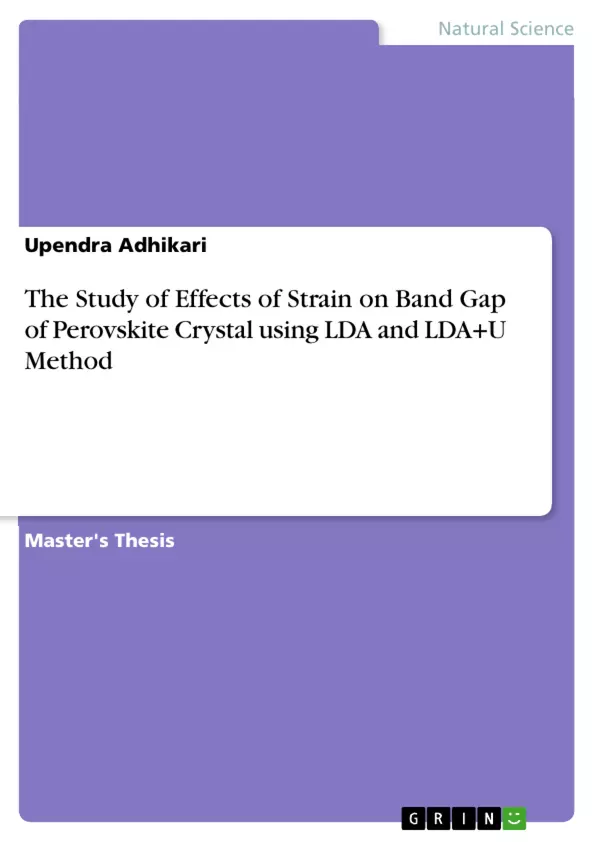Calcium Titanate (CaTiO3) is a ceramic material having simple cubic crystal with perovskite structure. It is a diamagnetic colourless solid but appears coloured due to the presence of impurities. This materal can be used for semiconductor, laser, microwave, biochemical applications and photovoltanics.
We have performed density functional theory (DFT) to study the optimized geometric structure, local density approximation (LDA) and local density approximation using Hubbard potential(U)(LDA+U) to study the effect of strain on the atomic displacement of Oxygen and Titanium atoms, band gap and partial density of states (PDOS). The band gap obtained during our present work is in close approximation with the experimental band gap indicating CaTiO3 is an insulator with indirect band gap.
Inhaltsverzeichnis (Table of Contents)
- Introduction
- Introduction to pervoskite structure
- Introduction to CaTiO3
- Structure
- Formation of band gap
- Scope of present study
- How we approach?
- Theoritical Background
- General Consideration
- Many-Body Hamiltonian and Born-Oppenheimer Approximation
- Hartree-Fock Method of Self Consistent Fields
- Density Functional Theory
- General Consideration
- Thomas-Fermi Model
- Hohenberg-Kohn Theorem
- The Kohn-Sham Formalism
- The Exchange -Correlation Functional
- Local Density Approximation
- Generalized Gradient Approximation
- Solution of the Kohn-Sham equations: Self-consistency iteration procedure
- LDA+U Method
- Computational Details
- General Consideration
- PWscf
- Post Processing
- General Consideration
- Results and Discussion
- Convergence Tests
- Kinetic energy cut-off(ecutwfc)
- K-points grid
- Lattice parameter
- Band structure
- LDA Method
- Calculation of band structure of perovskite CaTiO3 by LDA method
- Effect of strain on atomic displacement by LDA method
- Effect of strain on indirect band gap by LDA method
- Effect of strain on direct band gap by LDA method
- Partial density of states of perovskite structure of CaTiO3 by LDA method
- LDA+U Method
- Determination of Hubbard potential
- Calculation of band structure of perovskite CaTiO3 by LDA+U method
- Effect of strain on indirect band gap by LDA+U method
- Effect of strain on direct band gap by LDA+U method
- Partial density of states of perovskite structure of CaTiO3 by LDA+U method
- Comparision of band gap between LDA and LDA+U method.
- Convergence Tests
- Conclusions and Concluding Remarks
Zielsetzung und Themenschwerpunkte (Objectives and Key Themes)
This dissertation investigates the effects of strain on the band gap of the perovskite (CaTiO3) crystal using first-principles calculations. The study utilizes Density Functional Theory (DFT) under Local Density Approximation (LDA) and LDA with Hubbard potential (LDA+U), implemented with Quantum ESPRESSO code. The primary objective is to determine the optimized geometry and electronic properties of CaTiO3 while exploring the impact of inplane strain on its band gap and polarization.
- The study aims to determine the optimized geometry and electronic properties of CaTiO3.
- The research investigates the influence of inplane strain on the band gap and polarization of CaTiO3.
- The dissertation analyzes the effects of strain on the atomic displacement of oxygen and titanium atoms within the CaTiO3 crystal structure.
- The work compares the results obtained using LDA and LDA+U methods to understand the impact of the Hubbard potential on the calculated band gap.
- The research explores the relationship between strain and the electronic band structure of CaTiO3, including the contribution of different atomic orbitals to the valence and conduction bands.
Zusammenfassung der Kapitel (Chapter Summaries)
The introduction provides a comprehensive overview of perovskite structures, focusing on the specific properties of CaTiO3. The study's scope and methodology are also outlined. Chapter 2 delves into the theoretical framework, discussing fundamental concepts like the Born-Oppenheimer approximation, the Hartree-Fock method, and Density Functional Theory. It further explores various exchange-correlation functionals and the LDA+U method. Chapter 3 presents details about the computational methods employed in the study, including the Quantum ESPRESSO code and convergence tests for key parameters. The subsequent chapters delve into the results and discussions, encompassing the impact of strain on the band gap, atomic displacements, and electronic band structure. These chapters compare findings obtained using both LDA and LDA+U methods, highlighting the differences in the calculated band gaps.
Schlüsselwörter (Keywords)
This dissertation focuses on the electronic structure and properties of the CaTiO3 perovskite crystal. The study explores the effects of inplane strain on the band gap, atomic displacements, and electronic band structure of this material. The research utilizes Density Functional Theory (DFT), employing both Local Density Approximation (LDA) and LDA with Hubbard potential (LDA+U) methods for calculations. The primary keywords include: Perovskite, CaTiO3, Band Gap, Strain, Density Functional Theory, LDA, LDA+U, Electronic Structure, Atomic Displacements, Quantum ESPRESSO.
- Quote paper
- Upendra Adhikari (Author), 2017, The Study of Effects of Strain on Band Gap of Perovskite Crystal using LDA and LDA+U Method, Munich, GRIN Verlag, https://www.grin.com/document/419048



